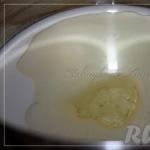When raw firewood and household waste are burned in a stove, it releases large number soot, which Because of this, thrust decreases and the intensity of fuel combustion decreases. The result of this phenomenon may be poisoning of people carbon monoxide, which stops leaving the room. A chimney brush can solve the draft problem. This device is considered the most effective means to resolve such problems. Let's look at what it is, its structure, types, advantages and disadvantages.
Boilers and stoves are installed in almost all private houses and cottages, bathhouses and garages. As a rule, firewood or coal is used to fire them. But quite often hearths are used to dispose of old tires, household items and construction waste. These items emit thick smoke, which settles as particulate matter on the interior walls. exhaust pipe. Gradually thickening, the soot completely blocks the exhaust duct.
In addition, chimneys become clogged for the following reasons:
- ingress of branches, leaves, small animals and bird nests;
- partial or complete destruction channel due to wear or improper assembly;
- , which upon contact with combustion products forms a viscous and sticky substance.
Signs of a clogged chimney include the fallout of soot fragments into the firebox during boiler cleaning, poor combustion of fuel when the ash pit is open, poor traction and strong soot when burning fuel.
How can you clean a chimney?
In order to clean the pipe coming from the boiler, stove and fireplace, there are many ways and means.
They are divided into the following categories:
- Thermal. The essence of this method is to destroy the blockage high temperature. An object is placed in the firebox or directly in the chimney, which produces intense heat when burned. Termite blocks, anthracite and aspen firewood give good results. The carbon deposits are burned off manually with a gas burner.
- Chemical. They are available in the form of tablets, granules and powders. The funds are placed on smoldering coals. Under the influence of heat, ingredients are released that turn soot into dust, which completely crumbles into the firebox within a few days.
- Mechanical. To remove blockages, scrapers, brooms and brushes are used. Foreign objects are removed with a hook or crowbar. Flexible garden hoses, hoes, logs and weights on a rope, poles and telescopic fishing rods, and other improvised means are used as auxiliary tools.
There are also folk remedies chimney cleaning. Carbon deposits are removed by combustion in the firebox potato peelings, pouring water on it, immersing compacted snow in a heated pipe.
Advantages and disadvantages of a brush
The most difficult thing to remove is soot that has filled almost the entire volume of the channel. In addition, the length of the chimney also plays a role. In some buildings it can be ten meters or more. It is simply impossible to work with poles of such length.

A brush on a cable has the following advantages:
- light and compact, easy to carry and transport;
- no restrictions on pipe height, shape and section size;
- the ability to adjust the weight of the load and, accordingly, the applied force.
The disadvantages of this device include its inability to break through solid blockages, remove condensation and remove foreign objects.
How the ruff works
The brush for cleaning chimney pipes consists of the following parts:
- Head. It is a hard pile fixed to the base, made of metal or plastic.
- Weighting agent. It is made in the shape of a ball or cylinder, made of iron or lead.
- Cable. It is the basis for fastening all parts. Made from iron or synthetic fiber.
- Hook. Located on the cable between the head and the load.
- Tubes They are mounted on a cable and are designed to create a dynamic force when pushing the brush down.
- Replaceable nozzles. Performed in the form of a pike or hook. Designed for breaking through obstacles and extracting dense objects.
To clean pipes of certain shapes, brushes with different parameters are used.
Types of ruffs
The selection of these devices is made according to the following criteria:
- Diameter. It can be small (up to 100 mm), medium (100 -250 mm) and large (more than 250 mm).
- Material of manufacture. Heads are made of copper, iron and polymer plastic.
- Form. Round, polygonal, oval, square.
- Type of cable. The working part is attached to a rope, plug tubes or cable located inside the tubes.
You should also pay attention to the weight of the sinker. It varies between 5-20 kg.
Make it yourself or buy it
This question invariably faces owners of property heated with coal or wood. If you have the skills to handle household tools making a pipe cleaner is not difficult.

But this will require spending time, which everyone is sorely lacking. It is much easier to purchase a finished product from a factory. Fortunately, today in retail trade There is a wide range of similar products available, and their prices are quite reasonable.
When purchasing chimney cleaning devices, you should not focus on their cost. A cheap purchase may not be effective and will sit in the pantry for years.
The following factors need to be taken into account:
- can be processed with any material;
- To clean ceramic pipes, only a plastic brush may be used;
- steel chimneys can be cleaned with heads with bristles made of copper or brass;
It is better to purchase a weight with two eyes so that you can tie a rope to it and pull it down if it gets stuck.
The most popular brushes are from the following manufacturers:
- PCC (Poland) - plastic and metal, with a diameter of 120-400 mm;
- Hansa (Lithuania) - universal 150-400 mm;
- Chimney sweep (Russia) - set with replaceable nozzles.
Making a ruff with your own hands
This is a creative and interesting activity that you can do in your spare time. personal plot time or in the off-season. Before you start work, you need to prepare everything you need for this.
Required materials and tools
To make a chimney brush with your own hands you will need:
- hacksaw or grinder;
- pliers;
- adjustable wrench;
- steel washers;
- hard wire;
- hairpins;
- bolts and nuts;
If you have to clean ceramic pipe, then you will need scissors to cut plastic bottles.
Drawing and diagrams
To make the brush convenient, durable and functional, its design needs to be carefully thought out. As a basis for planning, you need to take a scale drawing of the chimney. Based on the available data, diagrams of individual components of the brush and the entire product as a whole are drawn up.

The following details are displayed in detail on paper:
- shape and size of the cargo;
- carabiner for attaching it;
- head device;
- carabiner loop;
- cable configuration.
After checking the schemes, final calculations are carried out.
Size calculation
Help for making a cleaning brush project stove chimney the table will serve:
How to make a ruff
Let's look at how a brush is made from plastic bottles.

- We take 5-6 containers of the same size, remove the lids from them and cut off the bottom at the same distance.
- Using scissors, cut strips 4-5 mm wide from the bottom to the neck.
- We join the resulting blanks together. We fix them with wide washers, a nut and a bolt with a head made in the shape of a loop.
- We make a weighting material from an iron can, lead and a thick steel pond. We attach a durable carabiner to the ring.
- We string thin steel or aluminum tubes 80-100 cm long. Cable using an adapter with internal thread screw it to the head.
The chimney brush is ready.
Production video
Frequent mistakes and problems when making brushes
The main difficulty in making a brush is finding suitable material. The most difficult thing to make is the head of the device. At this stage, precision and considerable effort are required.
Most masters make the following mistakes:
- Short cable length. As a result, the brush does not reach the end of the pipe. As a result, the most inaccessible area near the firebox remains clogged.
- Poor tightening of the wire between the washers. This leads to the destruction of the homemade brush during the process of cleaning the chimney.
- The pole or plugs are not strong enough. When loaded, these parts bend, preventing the brush from advancing. In the worst case, the handle breaks and its fragments get stuck in the pipe.
- Selecting a cleaning material that does not match the internal surface of the chimney. Thus, a metal brush can hopelessly ruin ceramics.
- The head width does not match the channel parameters. The head either does not fit into it or does not reach the walls.
Rules for cleaning a chimney with a brush
Since access to the pipe is only possible from the roof, it is necessary to pay attention special attention security measures. The worker must use a safety line; it is advisable to set up a temporary barrier.
- Before starting cleaning, close the firebox and vent tightly.
- Check the tool for serviceability. Test all parts for strength.
- After passing each meter of pipe, remove the crumbled soot from the firebox.
- After completing the passage of the pipe, use a hard brush to replace it with a soft one for final polishing of its walls.
Professional chimney sweeps know the secrets of quickly and efficiently removing blockages of any complexity.

If you have a solid fuel unit in your house, you will have to make a brush to clean the chimney with your own hands. You can, of course, buy it ready-made, but it’s too simple. It’s more interesting to make it yourself from scrap materials, while singing: “You need to clean the pipes cleanly in the mornings and evenings, and shame on dishonest chimney sweeps.”
Why clean the chimney?
Owners of stoves and fireplaces should make it a rule to carry out chimney maintenance at least once a year. This is not a very labor-intensive task, but it will prevent a fire or explosion of soot in the smoke ducts, support good traction, monitor the condition of the walls brick chimney.

Required Tools
Chimney cleaning is an activity to remove soot from the walls of the chimney and smoke channels.

Special tools are designed for this:
- Ruff– metal brush cylindrical, the core of which is a wire twisted in a spiral. IN lately Nylon is used as bristles, and the shape can be rectangular. Usually comes complete with a rope (cable) and a core (2-3 kg). The core in this system functions as a sinker for lowering and cleaning, and a ram for breaking through blockages. At home, it is better to use a brush with a handle, which is made along the length of the chimney - stacked or solid.

- Brush– metal and polymer, equipped with a handle. If uncleaned areas of the chimney form after the brush, the defect can be eliminated using a brush. For heavy dirt, a metal brush is used; for soot, a polymer brush is used.
- If soot or soot build-up has formed in the chimney, a scraper will come to the rescue. It can be flat or oval for chimney pipes. If necessary, the handle can be extended.

At home, making a metal brush for cleaning a chimney will require some effort and skill. It is much easier to make a ruff from simple materials.
Making a brush from scrap materials
To make it you will need a 1.25 liter plastic bottle, a metal pin 11 cm long, 8-10 mm in diameter, and two eyes with internal threads. The tools you need are a drill and a knife.
| 1. | The instructions are simple. The first step is to burn a hole in the center of the bottom of the bottle. It is better to do this with a hot rod corresponding to the diameter of the pin. |
 |
| 2. | A hole is drilled or burned out in the lid |
 |
| 3. | The bottle is cut into strips 1.5-2 cm wide. An eye is screwed onto the pin from one edge |
 |
| 4. | The eye pin is inserted into the bottle and with opposite side the second eye is screwed in. |
 |
| 5. | Now, using carabiners, the core and rope (cable) are attached. |
 |
The produced brush is suitable for cleaning steel or asbestos-cement pipes with a diameter of 150 mm. For diameters 100 and 120 mm, it is better to take a half-liter bottle.
How to construct a brush from a broom?
Nowadays many people use synthetic brooms. The new broom sweeps well, but then begins to spread out.
This one is suitable for cleaning chimney brushes:
| 1. | The broom should be round and made of polypropylene. The handle is unscrewed or cut off. For ease of operation, the broom must be clamped in a vice or inserted into a hole along the diameter of the sealing coupling threaded connection with a cutting. |
 |
| 2. | The broom bristles need to be straightened. This works well with a hairdryer. Then you need to take a metal pin 8 cm long, put on a washer and screw on the eye. |
 |
| 3. | A metal pin with a twisted eye is inserted from the handle side. Another eye with a plate along the diameter of the sealing coupling is screwed on the bristle side. |
 |
| 4. | The structure is tightened all the way with lugs. A cable (rope) and a load (core) are secured. |
 |
Perfectly cleans pipes with a diameter of 180 and 200 mm. For smaller sizes, the bristles can be trimmed.
The second option is from a plastic bottle
A homemade chimney brush with an extended handle can be a good help in the fight against soot. It is very easy to make - you will need 10-12 mm plywood or OSB, a five-liter plastic bottle and screws.
The handle at home can be made from a long block of 3x4 cm or made from plastic pipes with a diameter of 25-30 mm. To work you will need tools: saw, drill, scissors, tape measure, pencil.
| 1. | There are probably pieces of plywood (OSB) and plastic bottles on the farm. |
 |
| 2. | Two plywood plates 240x120 mm are cut (for a chimney 260x130) |
 |
| 3. | The center is located along the diagonals and a hole is drilled for the handle. |
 |
| 4. | The neck and bottom are cut off from the bottle. A sheet measuring 264 by 134 mm is cut out of the resulting box. Incisions are made along the perimeter with scissors (knife) every 1.5-2 cm. |
 |
| 5. | A plastic sheet is placed between plywood blanks, which are fastened with screws. Try to ensure that the plastic protrudes the same distance beyond the edges of the plywood. The handle is secured. |
 |
There are several more ways to make a chimney brush with your own hands:
- First consists of using a mop to clean the floors. Optimal diameter chimney – 150 mm. You can clean it both from above with an extended handle, and from below using a flexible cable of 8-10 mm.


- Second way slightly more expensive - a wire brush is used to mechanical removal rust. You can buy a new one - its price is low, you can use a used one.

The video in this article will help you understand the process.
02.03.2017
4589
Pechnik (Moscow)
In order to clean the chimney, there is no need to buy the entire necessary tool in specialized stores. In this article, we will talk about how to make a brush for cleaning a chimney with your own hands.
Main materials of manufacture and characteristics
If you have a stove or fireplace in your home that operates through a chimney, then this unit certainly needs quality cleaning periodically. A do-it-yourself chimney brush will allow you to make this process simple, and the result is guaranteed to be positive.
The main design of this device is represented by a large flexible cable on one side of which there is a load, and on the other a special brush.
Important: cleaning can be done from any side. Depending on the shape, type and size of the pipe (from the roof, from the side of the house or through special holes).For the manufacture of this design, they are most often used following materials:
- The base is made of wire or metal cable. It is important that this part is as flexible, durable and not brittle as possible;
- It is possible to use special plastic cords or fishing line with large diameter;
- For better grip, secure the frame with springs;
- Plastic bottles can be used as a base;
- One of the most durable and inexpensive materials, the price of which is affordable, is rubber.
A brush with a large diameter and medium-hard bristles
Choosing a tool depending on the type of chimney
- To clean brick chimneys, use brushes that have a regular rectangular or square shape brushes with the most rigid and dense bristles;
- Pipes made of stone can be cleaned well and quickly with products that have a rectangular or round shape;
- For metal pipes Brush brushes of any size, shape and cross-section are suitable, since the surface of the product is as smooth as possible and is easy to clean, even in the presence of heavy dirt and a dense layer of soot.
Tip: If you want to find a soot removal product that is ideal for your overall dimensions and shape, we recommend using a homemade brush to clean the chimney.
Manufacturing instructions
At the first stage of making a product with your own hands, you need to pay attention to the following points:
- Determine the length of the chimney and, based on accurate calculations, make a flexible base of this size;
- In order to determine the size of the tool, it is necessary to measure the diameter of the pipe. The product must move freely and fit into inner part, don't get stuck;
- Select a bristle with the optimal degree of bristles stiffness and thickness. If there is a lot of dirt and the layer is large enough, you need to choose the hardest and thickest pile; the same rule applies to stone and brick pipes.
Important: the total length of the cable base must be calculated according to the following scheme: total length of the chimney + 2 meters for reserve.
At the end of the base, you need to tie a large and strong loop that can withstand total weight of the entire device and will not be able to come undone under the influence of the load during the cleaning process.
Manufacturing of cargo
A metal brush for cleaning a chimney must have not only a base and bristles, but also a weight that allows you to correctly position the center of gravity and significantly facilitates the work, allowing you to effectively remove dirt, plaque and soot from the walls of the structure.
- The main material for making a plumb weight is any round-shaped metal object. You can also use weights;
- It is recommended that the plumb line be represented by one element. In the absence of a weight or a large bolt, special metal plates can be used. Such elements must have a thickness of at least 6-10 centimeters;
- Another way to make cargo is special pipe, with a diameter of 50 to 60 millimeters. It is necessary to drill about 8 holes in such a pipe and secure the cable in this way.
Making a brush from bottles
Instructions for making a brush from plastic bottles:
- You need to take 4-5 bottles and cut off the bottom of each of them;
- Cut the sidewalls into small pieces - strips vertically;
- The cut should end at the edge of the container bend;
- The cuts should have different thicknesses;
- The blanks must be connected in such a way that the largest strips are on the outside of the product;
- Bottles with smaller stripes must be inserted inside and the neck cut off;
- In order to secure the structure, you need to screw the base with a simple lid;
- You need to make a small hole in the lid and insert it into it. flexible cable;
- The end of the cable must be finished with a loop for subsequent installation of the weight;
- A flexible cable is inserted into the loop at the end and turned clockwise;
- To make pile, you can use both sheet rubber and plastic;
- The brush is mounted on a metal pin, the length of which is from 20 to 25 centimeters;
- Fixation is done with a washer. The length of the teeth can vary. The space between them is filled with the same rubberized or plastic material, only shorter length;
- The washer must be additionally secured with a nut.

Important: if you want to make products for cleaning a brick chimney, it is recommended to use large 4-liter bottles with a square bottom.
Tip: to make the plastic bristles much harder, pre-treat them with a soldering iron or heat them to harden them.
You can view photos of cleaning brushes in this article.
The second option for making a brush for 10 minutes
- The base of a plastic bottle, the widest part, is used as the base of the brush;
- We cut the base into horizontal sections, there should be from 5 to 8 pieces in total;
- We make large cuts on the sides and make a hole in the center of each part, suitable in diameter to the cable;
- We thread the connector into the hole and secure it on one side with a washer;
- We use hardware as a hook for the load;
- We attach a round or oblong metal weight to the hook.
Stove soot is removed from chimneys as follows:
- burning off carbon-rich deposits using rather complex technology and expensive tools;
- dissolving the settled crust using chemicals introduced into the furnace during fuel combustion;
- scraping from the inner surface and removing from the outlet channel through pre-arranged hatches for cleaning.
Moreover, the first method of combating is extremely dangerous and is practiced only in the case of cleaning chimneys of industrial heat-generating units. The second method involves the destruction of the body of the outlet pipe, which has survived the effects of chemically active drugs.
The third technology – mechanical cleaning – guarantees high level safety, while ensuring the safety of the chimney itself. Therefore, most household drainage channels furnace gases clean only with your own hands mechanically.
Why do you need a brush and how is it used?
This tool works like a scraper or brush, destroying the soot crust and “sweeping” combustion products to the cleaning hatch, for subsequent removal of collected deposits. That is, mechanical cleaning of the canal is carried out precisely with its help.
The chimney sweep inserts a brush into the drainage channel from the roof side and, making reciprocating movements, knocks soot off the inner walls.

Having finished processing the vertical channel, the chimney sweep proceeds to cleaning the horizontal sections, inserting the brush into special hatches and making reciprocating movements already in horizontal plane.
The mass accumulated at the hatch is removed from the channel using a scraper and scoop.
How does a chimney sweep's main tool work?
Typical stove brush consists of such structural elements as:
- flexible cable - a spring with a minimum gap between turns;
- a spherical or cylindrical brush – a brush – with “working elements” protruding 360°;
- suspension - a removable weight at the end of the cable located behind the brush.
When working in a horizontal plane, the suspension is dismantled - in this case we need the flexibility of the spring cable. Cleaning a vertical channel with your own hands involves working with a rigid structure. Therefore in in this case a suspension is fixed at the end of the cable, which neutralizes the flexibility of the spring due to the influence of gravity.

In addition, at professional tool the brush is removed by twisting it from the cable, because the diameters of the chimneys can be different.
How to make a brush for cleaning with your own hands?
For this we need following tools and consumables:
- The plumbing cable is the basis for the future brush. However, if only a vertical channel is intended to be processed, then the spring cable can be replaced with a wire analogue or a fine-mesh chain.
- A roll of soft wire - this will be used to make a cleaning attachment. If there is no wire, then you can use tire cord after burning out the rubber. Another option for “construction” material for the nozzle is a plastic bottle.
- Any small-sized load - a heavy nut, a cast lead blank. A coffee can filled with sand or shot.
- Steel pin 8-10 millimeters, two nuts, two carabiner fasteners, copper tube.
- Two tiles measuring 5x5 centimeters made of plywood or metal with a thickness of at least 2 mm

The process of making a pipe cleaner with your own hands is as follows:
- At the point of intersection of the diagonals of 5-centimeter tiles, we drill through hole diameter like a hairpin.
- We cut the cord or wire into measured pieces, the length of which is equal to 2-2.5 times the diameter of the chimney.
- We take the pin, fix it in a vice and bend the free end into a loop or weld washers with a large internal diameter to it.
- Next, turn the pin over in the vice with the threaded end up, screw on the first nut on this side and put on the first tile.
- We bend measured pieces of cord or wire in half, around the pin, forming a ruff. In this case, the wire bristles should be located evenly around the entire circumference for maximum area cleaning.
- We put the second tile on the stud and screw on the second nut, fixing the wire sticking out in different directions.
- Using welding, we attach a second washer to the free end of the pin or make a loop.
- We pass the carabiner fasteners through the loops or vertically fixed washers, obtaining a removable attachment for the brush for cleaning.
- We weld or solder the mounting ring to the load. If a nut is chosen as a suspension, then this operation can be abandoned.
- We attach the weight to one of the carabiners of the assembled attachment.
- We put it on the free end of the spring or weeding cable copper tube 4-5 centimeters long. The diameter of the tube is equal to 2-2.5 times the diameter of the cable.
- We form a loop at the end of the cable, passing the free section into the tube.
- We rivet the copper tube, fixing a loop for hanging the nozzle with a weight.
- We fix the cleaning head on the loop using a free carabiner.

That's it. You have made a brush with your own hands for cleaning the vertical channel of a stove or fireplace pipe, and it is ready for use.
But to process horizontal or inclined channels you will need a completely different attachment, which you can also make with your own hands:
- Take it plastic bottle 1.5-2 liters and cut off the bottom of this container.
- Unravel the body of the bottle into strips 3-4 millimeters wide, cutting them along the vertical axis from the distant bottom to the neck of the container.
- Punch a hole in the cover, the diameter of which coincides with the diameter of the cable.
After this, you will have to string a perforated lid onto the cable and, having first removed the “vertical” nozzle from the loop, screw the bottle turned into a scraper onto it. Moreover, to firmly fix the nozzle on the brush, it is necessary to pierce the neck and plug with a self-tapping screw, passing it through the loop on the cable.

When making parts with your own hands, you should consider:
- The diameter of the brush is 0.8-1.2 times the diameter of the chimney.
- The diameter of the load is 0.3-0.35 of the diameter of the channel being cleaned.
- Length of spring or wire rope = length of channel being cleaned + 10-15 percent.
We can say that a chimney brush is the main tool used for the hygiene of this structure. The device is somewhat similar to toothbrush for cleaning bottles, the principle and overall appearance are very similar, naturally only the sizes are much larger. The ruff consists of a main spire (also known as the central perpendicular), on which several circles of large “bristles” are made. Often thin steel wire is used, in some cases it is permissible to use only soft types wire.
Despite a general understanding of the cleaning procedure and an overview of the entire device, many are unaware of significant factors when purchasing finished products. It should be taken into account that the tool is not suitable for every type of channel. For example, for brick structures, a brush with hard “bristles” is suitable, where the “bitten” soot is “settled” quite tightly on the walls. If you are buying for steel pipe, purchase soft products, with soft wire or plastic, nylon. Otherwise, the rigid wire may damage the structure. As you can see, there are enough nuances in choosing ruffs and it is important to pay attention to them.

Brush for cleaning a brick chimney
Where is it sold and how much does it cost?
You can buy such a device at any hardware store. If you don't have it, you can purchase a brush for your chimney on the Internet; as a rule, the cost does not differ significantly. Average price within 2,000 rubles.
How to make a homemade brush?
If the price seems too high for you, you can make such products yourself. The main thing is to determine exactly what shape you need and for which pipe. There are three main types of brushes:
- The brush is a classic metal brush, shaped like a cylinder. Additional devices included in the kit can be either a simple long rope, usually 5 meters, or a weight weighing up to 2 kg. with extension cord.
- A regular brush equipped with steel or nylon bristles. Has a special handle.
- Scraper. It saves the day when there are soot build-ups on the channels that the two previous options cannot cope with. Can be of any suitable shape.
From a plastic bottle
A homemade brush can be made from an ordinary water bottle. Manufacturing stages:
- In the center of the bottom, make a small hole.
- A hole of the same diameter is made in the lid.
- Next, cut the bottle into small strips and attach a pin with a hook to one side.
- On the other side, a pin is also inserted, which are connected together.
- Using nuts, compress the bottle and attach a weight to one side.

The process of making a plastic brush
This design is suitable for cleaning metal and ceramic channels.
From the broom
A chimney brush can be made from an ordinary plastic broom, which is now available in almost every household. Manufacturing stage:
- Cut off the stalk.
- Straighten the “stubble”; you can use a hair dryer. After straightening, we clamp it with a pin and washer.
- From the side of the handle we wind a pin with a hook.
- The structure is tightened on both sides, then a cable with a sinker is attached.

Excellent for cleaning wide channels.
From a metal brush for an angle grinder
A metal brush or brush can even be made from such a device. On at the moment the price is not that high, so we recommend buying a finished product. If you decide to make a chimney brush with your own hands, remember that you will need two sheets, a threaded rod and nuts. Also, do not forget to use stiff wire or, in some cases, nylon wire as “bristles.”

A complex version made of metal cable
A cable can also be used to clean chimneys. The manufacturing process is much more complex and requires certain efforts and skills. You will need a cable, preferably at least 1 cm in diameter. An edge of about 10 cm dissolves into individual fibers. They bend into different sides, and in order to hold the mold to clean the pipe, two plates are taken and compressed. A counterweight should be attached to the bottom edge to break up lumps and soot build-ups.

















